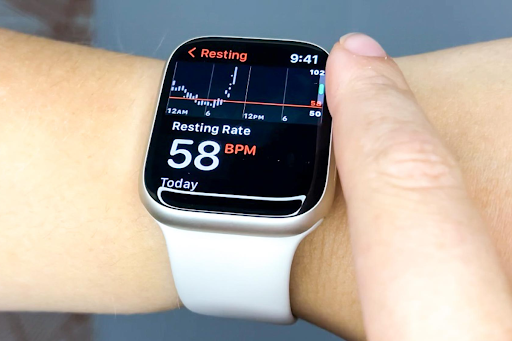As healthcare technology increases, perhaps one of the most frequently asked questions is: Is it actually possible for a blood pressure watch to track the wellbeing of the heart? The reply is yes—provided you select the right one. A blood pressure watch utilizes optical sensors and smart algorithms to give you immediate measurement of your blood pressure so that you are able to monitor your cardiovascular health better than ever before.
There are a few users looking for the Apple Watch blood pressure features. Although the current Apple Watch blood pressure tracking is not natively included, it operates in a seamless manner with third-party devices to give advanced blood pressure watch capability. Whether you have hypertension you need to track or you’re simply health-conscious, a blood pressure watch gives you your vital signs at your fingertips 24/7.
New blood pressure watch models not only track your BP but also measure your heart rate, oxygen levels, and even sleep. The Apple Watch blood pressure system is maturing, with more integrations guaranteeing greater precision.
Purchasing a blood pressure watch provides you with the power to monitor your own health. As new advances in Apple Watch blood pressure technology are made, the distinction between smart tech and medical-grade equipment dwindles. If heart health matters to you, a blood pressure watch is a smart step in the right direction.
What Is a Blood Pressure Watch & How Does It Work?
A blood pressure watch is a watch that tracks your blood pressure on your wrist—anywhere, anytime. Contrary to the traditional cuff, a blood pressure watch uses advanced sensors, e.g., photoplethysmography (PPG), to detect blood flow changes and estimate systolic and diastolic pressure. These smart devices sync with your smartphone to track and record over time, which makes it easier to monitor trends and share results with your doctor.
Most of the modern blood pressures watch brands also possess heart rate, sleep, and fitness tracking features, making them a health companion overall. The blood pressure watch is very beneficial to those who must contend with hypertension, heart complications, or simply people who want to be ahead of the game in terms of health complications.
While no blood pressure watch yet replaces a medical-grade monitor, they offer convenience and insight for daily wellness. Some, like the blood pressure monitor watch models that connect to apps or smart home systems, are highly user-friendly and accurate for general monitoring.
As technology advances year by year, wearing a blood pressure watch is a prudent option for any person who values the health of his or her heart and wants instantaneous information about the same on the wrist.
The Science Behind BP Watches
Wanna know how that blood pressure watch knows your vitals with the touch of your finger? Not magic, just cutting-edge technology. A blood pressure watch utilizes optical sensors to send light into your skin in order to sense changes in the flow of your blood. Photoplethysmography (PPG), the process whereby pulse wave velocity is calculated and used to approximate your blood pressure, does so.
In contrast to chunky cuffs, a blood pressure watch presents a thin, continuous, and non-invasive means of monitoring your heart health. Paired with robust algorithms, motion detectors, and occasionally even ECG technology, the blood pressure monitor watch can examine your cardiovascular rhythm and give real-time feedback.
It is possible now to become so adept with the technology that your blood pressure watch can alert you to erratic readings, pick up patterns, and even communicate with health apps for even smarter insights. With Bluetooth and cloud syncing, your blood pressure watch is your own personal health assistant—in your wrist.
This union of technology and biology is changing the way we monitor well-being. A blood pressure watch is not just an instrument—it’s a health revolution, making millions better educated, more active, and heart-intelligent each day.
Are BP Watches Just Fitness Gadgets or Lifesaving Tools?
In an era of fitness bands and smartwatches, it’s not difficult to wonder—is a blood pressure watch merely a fad, or could it actually save lives? The answer may surprise you.
A blood pressure watch goes far beyond counting steps or calories. It offers continuous, real-time insights into your cardiovascular health by measuring your blood pressure throughout the day. Using advanced optical sensors and AI algorithms, a blood pressure monitor watch tracks pulse wave velocity and heart rhythm, providing an accurate estimate of your systolic and diastolic pressure—all from your wrist.
This ongoing monitoring makes the blood pressure watch a more of an accessory than a sporting accessory. Those who have high blood pressure, cardiovascular disease, or stroke risk, a watch that can also track blood pressure can indicate dangerous spikes or erratic patterns—sometimes offering early reaction and medical assistance before catastrophe occurs.
Furthermore, the majority of blood pressures watch devices connect to smartphone applications, allowing individuals to store and share their health data with doctors or caregivers. This offers an added layer of security, especially for older patients or individuals who have chronic conditions.
So, just because it’s a stylish smartwatch-like gadget, a blood pressure watch can be a quiet watchdog—providing reassurance, pre-emptive alerts, and even lifesaving data. A blood pressure watch is not just smart in our digital age—it is essential.
Can Apple Watch Measure Blood Pressure
To April 2025, independent blood pressure measurement from Apple Watch is not available. However, individuals can monitor blood pressure through using the Apple Watch with the aid of external devices. Supported accessories are in most cases in arm cuff format and are paired through Bluetooth technology that easily supports connectivity with the Apple Watch Health application. This allows individuals to have easy monitoring of blood pressure results.
Several third-party blood pressure monitors are Apple Watch-compatible. For instance, the Omron Evolv Wireless Blood Pressure Monitor offers precise clinical results and features a built-in screen. It connects easily with the Apple Watch through the Omron Connect app. Another is the Withings Wireless Blood Pressure Monitor, which offers immediate color-coded feedback and generates comprehensive charts of previous measurements. These watches enhance the Apple Watch capability by the inclusion of blood pressure monitoring functionalities. Future models of the Apple Watch are rumored to incorporate blood pressure monitoring functions as a built-in feature. It is said that Apple is working on this feature, perhaps as early as 2025. But these features, however, will most probably be designed to detect hypertension and not provide precise systolic and diastolic readings.
In summary, while the Apple Watch cannot currently monitor blood pressure independently, it can be very helpful when used with compatible external devices to take blood pressure readings. Native blood pressure monitoring capability might be included in the Apple Watch in the future, making it an even more valuable tool for overall health monitoring.
Blood Pressure Watch vs. Traditional Cuff
The war of the new blood pressure watch versus the old-fashioned cuff is heating up. A blood pressure watch offers unmatched convenience—light, compact, and ideal for 24/7 monitoring. At home, at the office, or exercising, a blood pressure watch silently tracks your vitals around the clock in real-time. Unlike cumbersome monitors, no setup or tubing is required on a blood pressure watch.
But precision remains an issue of concern. Although an optical sensor and artificial intelligence-based blood pressure tracking smartwatch gives a reading estimate, the vintage cuff remains the gold standard for clinical precision. Yet, most consumers enjoy the convenience of a blood pressure tracking smartwatch for ongoing wellness monitoring.
With Bluetooth syncing, a blood pressure watch can store readings, show trends, and alert you to abnormal readings. A blood pressure watch also syncs with mobile health apps to enhance your personal health data experience. The old cuff can give accurate readings, but it cannot give the smart features that make the blood pressure watch more thrilling.
Last but not least, a blood pressure watch is best suited to pre-emptive health management, while a blood pressure monitoring watch introduces cutting-edge convenience into your cardiac treatment regimen. Making use of the two can supply you with the best balance between accuracy and comfort on your quest to health.
Advantages of Using a BP Watch
Wearing a blood pressure watch is more than just a techno gimmick—it’s a good decision on the path to better health. A blood pressure watch allows you to monitor your heart health on the go, giving you insightful data about your systolic and diastolic measurements without using a traditional cuff. With continual monitoring, a blood pressure watch can detect patterns and alert you to changes so you can intervene before small issues become big problems.
Today’s blood pressure watch is more than a basic monitor. It will often include features like heart rate tracking, sleep tracking, and even ECG functionality. All of those in one health companion sitting comfortably on your wrist makes it ideal for use every day, no matter if you’re at home, at the office, or on the move.
The other significant benefit of owning a blood pressure watch is data sharing and storage. Most devices synchronize with health applications, where you can keep your readings in digital form and have them easily sent to your physician. This enables more proactive and personalized care.
Whether you’re managing hypertension or simply staying health-aware, a blood pressure watch offers peace of mind, convenience, and the power to take control of your wellness—one heartbeat at a time.
Can a Blood Pressure Watch Detect Early Heart Issues?
A blood pressure watch can play a significant role in detecting early signs of heart issues, but it’s not a substitute for professional medical devices or diagnosis. By tracking your blood pressure over time, a blood pressure monitor watch provides consistent, real-time data that can reveal trends and irregularities. These patterns may suggest underlying heart problems like hypertension, arrhythmias, or other cardiovascular conditions.
The blood pressure watch keeps you updated every moment about your systolic and diastolic pressure, alerting you to spikes or drops that could be an indication of heart stress. The blood pressure watch also alerts you in instances of irregular readings, providing a heads-up to take measures or get the assistance of a healthcare practitioner.
For individuals at risk of heart disease or with heart disease in the family, a blood pressure watch is an proactive way to be up to date. It helps you take care of heart health by offering real-time monitoring and early intervention possibilities if necessary. Even though not a diagnostic instrument, a blood pressure monitor watch gives useful insights that can protect against serious cardiovascular diseases.
For More Read: Never Lose Sight: Must-Have Children Tracking Devices


